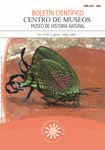Authors
Abstract
The composition, diversity and abundance of orb-web spiders were studied in three bordering habitats of the Laguna Negra, Galeras Flora and Fauna Sanctuary, corresponding to forest, shrubs, and grassland, identifying in each one the microhabitats and the vegetation stratum occupied by the orb weaver spiders where their webs and shelters are located. The orb weaver spider community was manually sampled by means of the “web revealing” technique, by sprinkling the vegetation with flour in order to visualize the threads. It is composed of three families: Araneidae, Tetragnathidae and Uloboridae, distributed in 6 genera, being Chrysometa the most dominant genus. Furthermore, it was seen that the shrub and grassland habitats share 77% of all the registered species, indicating the presence of more than one orb-web spider community, in more than one physiognomic type of vegetation. Regarding the stratum, both the low and high strata have the majority of individuals, possibly because of the wide availability of physical resources offered by the vegetation for the construction of their webs. Finally, the main factors that can influence the distribution and diversity of the orb-weaver spiders studied are: variety and amount of structural supplies in the vegetation and the availability of food.
Keywords
References
CEPEDA, J. & FLÓREZ, E., 2007. Arañas tejedoras: uso de diferentes microhábitats en un bosque andino de Colombia. Revista Ibérica de Aracnología, 14: 39-48.
CODDINGTON, J. & LEVI, H., 1991. Systematics and Evolution of spiders (Araneae). Annual Review of Ecology and Systematics, 22: 565-592.
COLEBOURNE, P.H., 1974. The influence of habitat structure on the distribution of Araneus diadematus. Journal of Animal Ecology, 43: 401-409.
COLWELL, R., 2005. Estimates: Statistical estimation of species richness and shared species from samples. Uso de la guía y aplicaciones (en) http://viceroy.eeb.uconn.edu/estimates.
COMSTOCK, J., 1948. The spider book. Vail Ballou Press.
EBERHARD, W., 1976. Photography of orb webs in the field. Bulletin of the British Arachnological Society, 3 (7): 200-204.
FLÓREZ, E., 1998. Estructura de comunidades de arañas (Araneae) en el Departamento del Valle, suroccidente de Colombia. Caldasia., 20 (2): 173-192.
__________., 1999. Estudio de comunidades de arañas (Araneae) del Parque Nacional Farallones de Cali, Colombia. Cespedesia, 23 (73-74): 99-113.
FLÓREZ, E. & SÁNCHEZ, H., 1995. La Diversidad de los Arácnidos en Colombia. Aproximación inicial: 327-372 (en) RANGEL, O. Colombia Diversidad Biótica I. Bogotá: Guadalupe Ltda.
FOELIX, R., 1996. Biology of spiders. Oxford University Press.
GREENSTONE, M.H., 1999. Spider predation: how and why we study it. The Journal of Arachnology, 27: 227-235.
GUNNARSON, B., 1990. Vegetation structure and the abundance and size distribution of spruce-living spiders. Journal of Animal Ecology, 59: 743-752.
HAMMER, O., HARPER, D.A.T. & RYAN, P.D., 2001. Past: Paleontological statistics software package for education and data analysis. Paleontología electrónica, 4 (1): 9.
INSTITUTO DE HIDROLOGÍA, METEREOLOGÍA Y ESTUDIOS AMBIENTALES DE COLOMBIA (IDEAM)., 2004. Regional Nariño-Cauca. Estación Obonuco, Pasto-Nariño.
JANETOS, A., 1986. Web- site selection: are we asking the right questions?: 9-22 (en) SHEAR, W., Spiders webs, behavior, and evolution. Stanford University Press, California.
LEVI, H., 1966. The neotropical orb-weaver genera Chrysometa and Homalometa (Araneae: Tetragnathidae). Bulletin of Museum of Comparative Zoology, 151 (3): 91-211.
__________., 1976. The orb-weaver genera Verrucosa, Acanthepeira, Wagneriana, Acacesia, Wixia, Scoloderus and Alpaida North of Mexico (Araneae: Araneidae). Bulletin of Museum of Comparative Zoology, 147 (8): 351-391.
__________., 2002. Keys to the genera of Araneid orbweavers (Araneae, Araneidae) of the Americas. The Journal of Arachnology, 30: 527-562.
MADRIGAL, A., 2001. Fundamentos de control biológico de plagas. Centro de Publicaciones Universidad Nacional.
MAGURRAN, A., 1989. Ecological diversity and its measurement. Ediciones Vedrá.
MORENO, C., 2001. Métodos para medir la biodiversidad. Editorial Manuales y Tesis (M&T) SEA. Vol. I.
MARSHALL, S. & RYPSTRA, A., 1999. Spider competition in structurally simple ecosystems. The journal of Arachnology, 27: 343- 350.
NYFFELER, M., 1999. Prey selection of spiders in the field. The Journal of Arachnology, 27: 317-324.
OPELL, B.D., 1979. A key to neotropical genera of Uloboridae. Bulletin of Museum of Comparative Zoology, 148 (10): 443-549.
RIECHERT, S. & CADY, A., 1983. Patterns of resource use and tests for competitive release in a spider community. Ecology, 64 (4): 899-913.
RIECHERT, S. & GILLESPIE, R., 1986. Habitat choice and utilization in web-building spiders: 23-48 (en) SHEAR, W. Spiders webs, behavior, and evolution. Stanford University press, California.
ROHLF, F. J., 2000. Numerical taxonomy and multivariate analysis system. Exeter publishing Ltd.
TURNBULL, A., 1973. Ecology of the true spiders (Araneomorphae). Annual Review of Entomology, 18: 305-347.

 PDF (Español)
PDF (Español)
 FLIP
FLIP


















